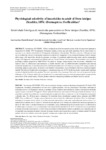Por favor, use este identificador para citar o enlazar este ítem:
http://www.alice.cnptia.embrapa.br/alice/handle/doc/974853Registro completo de metadatos
| Campo DC | Valor | Lengua/Idioma |
|---|---|---|
| dc.contributor.author | REDOAN, A. C. M. | pt_BR |
| dc.contributor.author | CARVALHO, G. A. | pt_BR |
| dc.contributor.author | CRUZ, I. | pt_BR |
| dc.contributor.author | FIGUEIREDO, M. de L. C. | pt_BR |
| dc.contributor.author | SILVA, R. B. da | pt_BR |
| dc.date.accessioned | 2014-01-03T11:11:11Z | pt_BR |
| dc.date.available | 2014-01-03T11:11:11Z | pt_BR |
| dc.date.created | 2014-01-03 | pt_BR |
| dc.date.issued | 2013 | pt_BR |
| dc.identifier.citation | Revista Ciência Agronômica, Fortaleza, v. 44, n. 4, p. 842-850, out./dez. 2013. | pt_BR |
| dc.identifier.uri | http://www.alice.cnptia.embrapa.br/alice/handle/doc/974853 | pt_BR |
| dc.description | Doru luteipes (SCUDDER, 1876) is considered one of the best natural enemies of the fall armyworm Spodoptera frugiperda (J. E. Smith, 1797) (Lepidoptera: Noctuidae), feeding on their eggs and small caterpillars. For its conservation it is necessary to use selective insecticides to S. frugiperda and harmless to the predator. Therefore, objective of the present work was to evaluate the toxicity of insecticides registered to control of S. frugiperda. It was conducted bioassays with D. luteipes adults treated with insecticides directly by exposure to residues of compounds applied on glass plates and the consumption of eggs of S. frugiperda contaminated and offered each one, 24 and 48 hours after treatment. The insecticides were classified according to indices proposed by IOBC/WPRS. For adults D. luteipes treated directly with insecticides, triflumuron was harmless (class 1); chlorfenapyr and etofenprox as slightly harmful (class 2) teflubenzuron/?-cypermethrin and spinosad moderately harmful (class 3) and thiamethoxan/? -cyhalothrin harmful (class 4). In bioassay exposure of D. luteipes residues of insecticides applied to glass plates, all products were harmful to the predator, except triflumuron which was considered slightly harmful. The survival of adults after consumption of contaminated eggs was 46.7% for the insecticide tiametoxam/? -cialotrina considered slightly harmful to the predator. The other insecticides were innocuous. Due to the low toxicity presented by the triflumuron to the D. luteipes adults, this compound can be recommended in programs aimed at integrated pest management the preservation of this natural enemy. All other products must be evaluated in greenhouse and field to prove its toxicity. | pt_BR |
| dc.language.iso | por | pt_BR |
| dc.rights | openAccess | pt_BR |
| dc.title | Physiological selectivity of insecticides to adult of Doru luteipes (Scudder, 1876) (Dermaptera: Forficulidae). | pt_BR |
| dc.type | Artigo de periódico | pt_BR |
| dc.date.updated | 2017-09-27T11:11:11Z | pt_BR |
| dc.subject.thesagro | Inseticida | pt_BR |
| dc.subject.thesagro | Pesticida | pt_BR |
| dc.subject.thesagro | Toxidez | pt_BR |
| dc.subject.thesagro | Praga de planta | pt_BR |
| dc.subject.thesagro | Lagarta | pt_BR |
| dc.subject.nalthesaurus | Toxicity | pt_BR |
| dc.subject.nalthesaurus | Pesticides | pt_BR |
| dc.subject.nalthesaurus | Insecticides | pt_BR |
| dc.subject.nalthesaurus | Plant pests | pt_BR |
| dc.subject.nalthesaurus | Insect larvae | pt_BR |
| riaa.ainfo.id | 974853 | pt_BR |
| riaa.ainfo.lastupdate | 2017-09-27 -03:00:00 | pt_BR |
| dc.identifier.doi | 10.1590/S1806-66902013000400022 | pt_BR |
| dc.contributor.institution | ANA CAROLINA MACIEL REDOAN, BOLSISTA; GERALDO ANDRADE CARVALHO, UFLA; IVAN CRUZ, CNPMS; MARIA DE LOURDES CORRÊA FIGUEIREDO, BOLSISTA; RAFAEL BRAGA DA SILVA, BOLSISTA. | pt_BR |
| Aparece en las colecciones: | Artigo em periódico indexado (CNPMS)  | |
Ficheros en este ítem:
| Fichero | Descripción | Tamaño | Formato | |
|---|---|---|---|---|
| Physiologicalselectivity.pdf | 72,1 kB | Adobe PDF |  Visualizar/Abrir |









